The Cambridge History of Japan, Vol. 1: Ancient Japan
Подождите немного. Документ загружается.

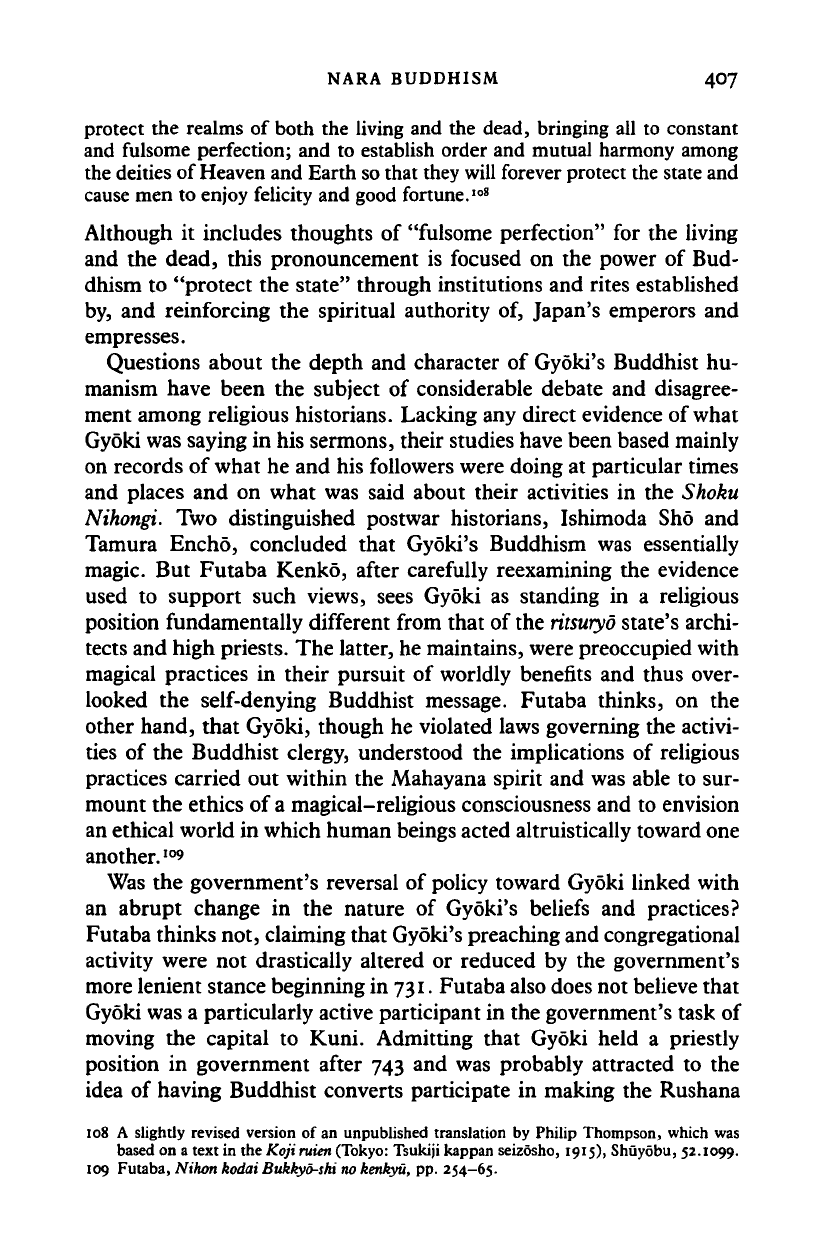
NARA BUDDHISM 407
protect the realms of both the living and the dead, bringing all to constant
and fulsome perfection; and to establish order and mutual harmony among
the deities of Heaven and Earth so that they will forever protect the state and
cause men to enjoy felicity and good fortune.
108
Although it includes thoughts of "fulsome perfection" for the living
and the dead, this pronouncement is focused on the power of Bud-
dhism to "protect the state" through institutions and rites established
by, and reinforcing the spiritual authority of, Japan's emperors and
empresses.
Questions about the depth and character of Gyoki's Buddhist hu-
manism have been the subject of considerable debate and disagree-
ment among religious historians. Lacking any direct evidence of what
Gyoki was saying in his sermons, their studies have been based mainly
on records of what he and his followers were doing at particular times
and places and on what was said about their activities in the Shoku
Nihongi. Two distinguished postwar historians, Ishimoda Sho and
Tamura Encho, concluded that Gyoki's Buddhism was essentially
magic. But Futaba Kenko, after carefully reexamining the evidence
used to support such views, sees Gyoki as standing in a religious
position fundamentally different from that of the
ritsuryo
state's archi-
tects and high priests. The latter, he maintains, were preoccupied with
magical practices in their pursuit of worldly benefits and thus over-
looked the self-denying Buddhist message. Futaba thinks, on the
other hand, that Gyoki, though he violated laws governing the activi-
ties of the Buddhist clergy, understood the implications of religious
practices carried out within the Mahayana spirit and was able to sur-
mount the ethics of
a
magical-religious consciousness and to envision
an ethical world in which human beings acted altruistically toward one
another.
IO
9
Was the government's reversal of policy toward Gyoki linked with
an abrupt change in the nature of Gyoki's beliefs and practices?
Futaba thinks not, claiming that Gyoki's preaching and congregational
activity were not drastically altered or reduced by the government's
more lenient stance beginning in
731.
Futaba also does not believe that
Gyoki was a particularly active participant in the government's task of
moving the capital to Kuni. Admitting that Gyoki held a priestly
position in government after 743 and was probably attracted to the
idea of having Buddhist converts participate in making the Rushana
108 A slightly revised version of an unpublished translation by Philip Thompson, which was
based on a text in the Koji
ruien
(Tokyo: Tsukiji kappan seizosho, 1915), Shuyobu, 52.1099.
109 Futaba, Nihon kodai Bukkyo-ski
no
kenkyu, pp. 254-65.
Cambridge Histories Online © Cambridge University Press, 2008
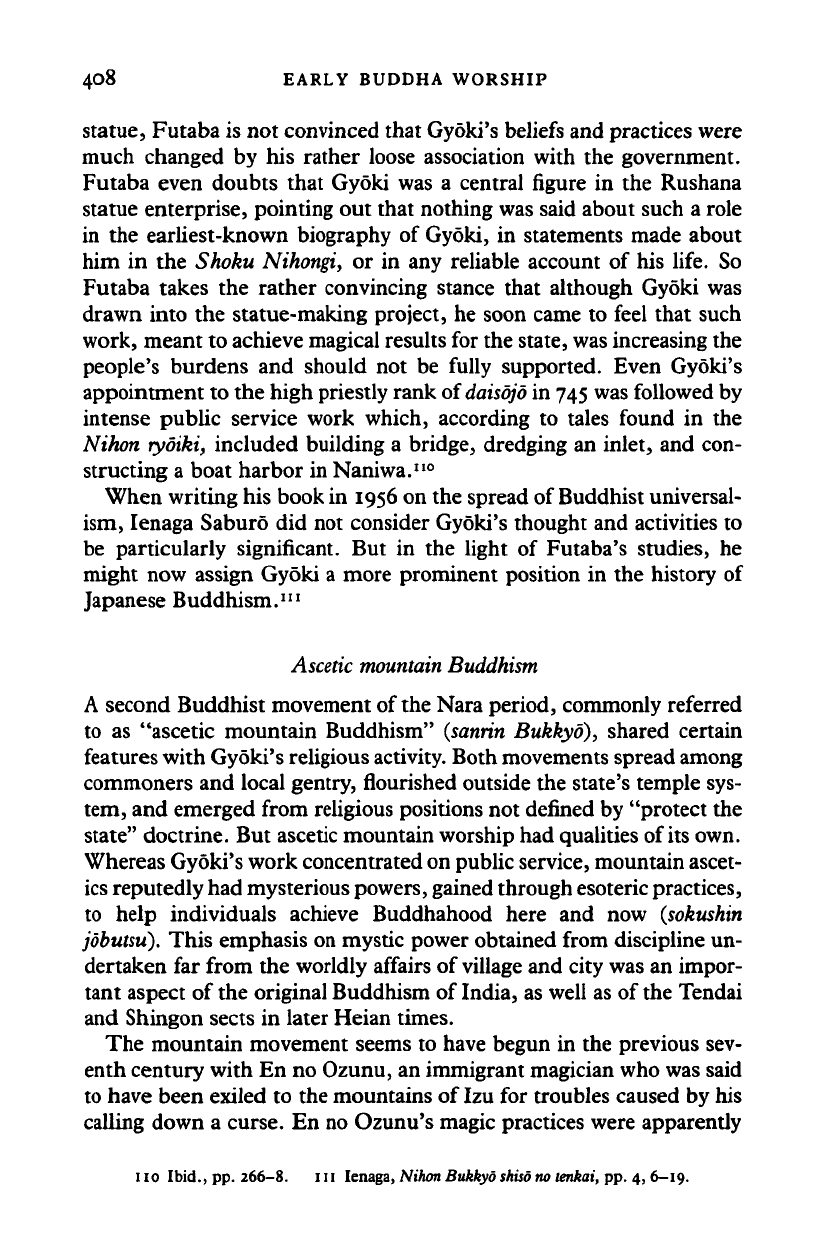
408 EARLY BUDDHA WORSHIP
statue, Futaba is not convinced that Gyoki's beliefs and practices were
much changed by his rather loose association with the government.
Futaba even doubts that Gyoki was a central figure in the Rushana
statue enterprise, pointing out that nothing was said about such a role
in the earliest-known biography of Gyoki, in statements made about
him in the Shoku Nihongi, or in any reliable account of his life. So
Futaba takes the rather convincing stance that although Gyoki was
drawn into the statue-making project, he soon came to feel that such
work, meant to achieve magical results for the state, was increasing the
people's burdens and should not be fully supported. Even Gyoki's
appointment to the high priestly rank of
daisqjd
in
745
was followed by
intense public service work which, according to tales found in the
Nihon ryoiki, included building a bridge, dredging an inlet, and con-
structing a boat harbor in Naniwa.
110
When writing his book in 1956 on the spread of Buddhist universal-
ism, Ienaga Saburo did not consider Gyoki's thought and activities to
be particularly significant. But in the light of Futaba's studies, he
might now assign Gyoki a more prominent position in the history of
Japanese Buddhism.
1
"
Ascetic mountain Buddhism
A second Buddhist movement of the Nara period, commonly referred
to as "ascetic mountain Buddhism"
(sanrin
Bukkyo), shared certain
features with Gyoki's religious
activity.
Both movements spread among
commoners and local gentry, flourished outside the state's temple sys-
tem, and emerged from religious positions not defined by "protect the
state"
doctrine. But ascetic mountain worship had qualities of
its
own.
Whereas Gyoki's work concentrated on public service, mountain ascet-
ics
reputedly had mysterious powers, gained through esoteric practices,
to help individuals achieve Buddhahood here and now (sokushin
jobutsu).
This emphasis on mystic power obtained from discipline un-
dertaken far from the worldly affairs of village and city was an impor-
tant aspect of the original Buddhism of India, as well as of the Tendai
and Shingon sects in later Heian times.
The mountain movement seems to have begun in the previous sev-
enth century with En no Ozunu, an immigrant magician who was said
to have been exiled to the mountains of Izu for troubles caused by his
calling down a curse. En no Ozunu's magic practices were apparently
110 Ibid., pp. 266-8. 111 Ienaga, Nihon Bukkyo
shiso
no tenkai, pp. 4, 6-19.
Cambridge Histories Online © Cambridge University Press, 2008
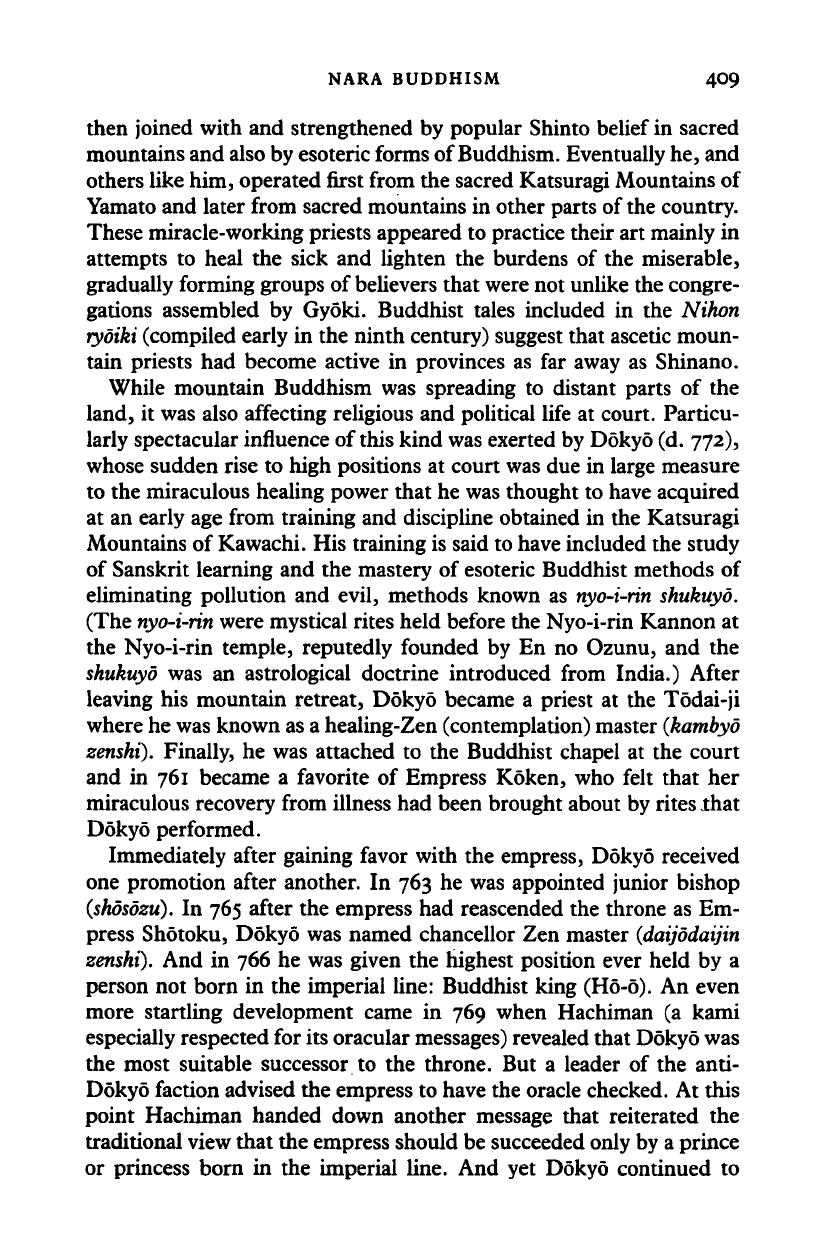
NARA BUDDHISM 409
then joined with and strengthened by popular Shinto belief in sacred
mountains and also by esoteric forms of Buddhism. Eventually he, and
others like him, operated first from the sacred Katsuragi Mountains of
Yamato and later from sacred mountains in other parts of
the
country.
These miracle-working priests appeared to practice their art mainly in
attempts to heal the sick and lighten the burdens of the miserable,
gradually forming groups of believers that were not unlike the congre-
gations assembled by Gyoki. Buddhist tales included in the Nihon
rydiki
(compiled early in the ninth century) suggest that ascetic moun-
tain priests had become active in provinces as far away as Shinano.
While mountain Buddhism was spreading to distant parts of the
land, it was also affecting religious and political life at court. Particu-
larly spectacular influence of
this
kind was exerted by Dokyo (d. 772),
whose sudden rise to high positions at court was due in large measure
to the miraculous healing power that he was thought to have acquired
at an early age from training and discipline obtained in the Katsuragi
Mountains of Kawachi. His training is said to have included the study
of Sanskrit learning and the mastery of esoteric Buddhist methods of
eliminating pollution and evil, methods known as
nyo-i-rin
shukuyd.
(The
nyo-i-rin
were mystical rites held before the Nyo-i-rin Kannon at
the Nyo-i-rin temple, reputedly founded by En no Ozunu, and the
shukuyd was an astrological doctrine introduced from India.) After
leaving his mountain retreat, Dokyo became a priest at the Todai-ji
where he was known as a healing-Zen (contemplation) master
{kambyo
zenshi).
Finally, he was attached to the Buddhist chapel at the court
and in 761 became a favorite of Empress Koken, who felt that her
miraculous recovery from illness had been brought about by
rites
jthat
Dokyo performed.
Immediately after gaining favor with the empress, Dokyo received
one promotion after another. In 763 he was appointed junior bishop
(shosozu).
In 765 after the empress had reascended the throne as Em-
press Shotoku, Dokyo was named chancellor Zen master
(daijodaijin
zenshi).
And in 766 he was given the highest position ever held by a
person not born in the imperial line: Buddhist king (H6-6). An even
more startling development came in 769 when Hachiman (a kami
especially respected for its oracular messages) revealed that Dokyo was
the most suitable successor to the throne. But a leader of the anti-
Dokyo faction advised the empress to have the oracle checked. At this
point Hachiman handed down another message that reiterated the
traditional view that the empress should be succeeded only by a prince
or princess born in the imperial line. And yet Dokyo continued to
Cambridge Histories Online © Cambridge University Press, 2008
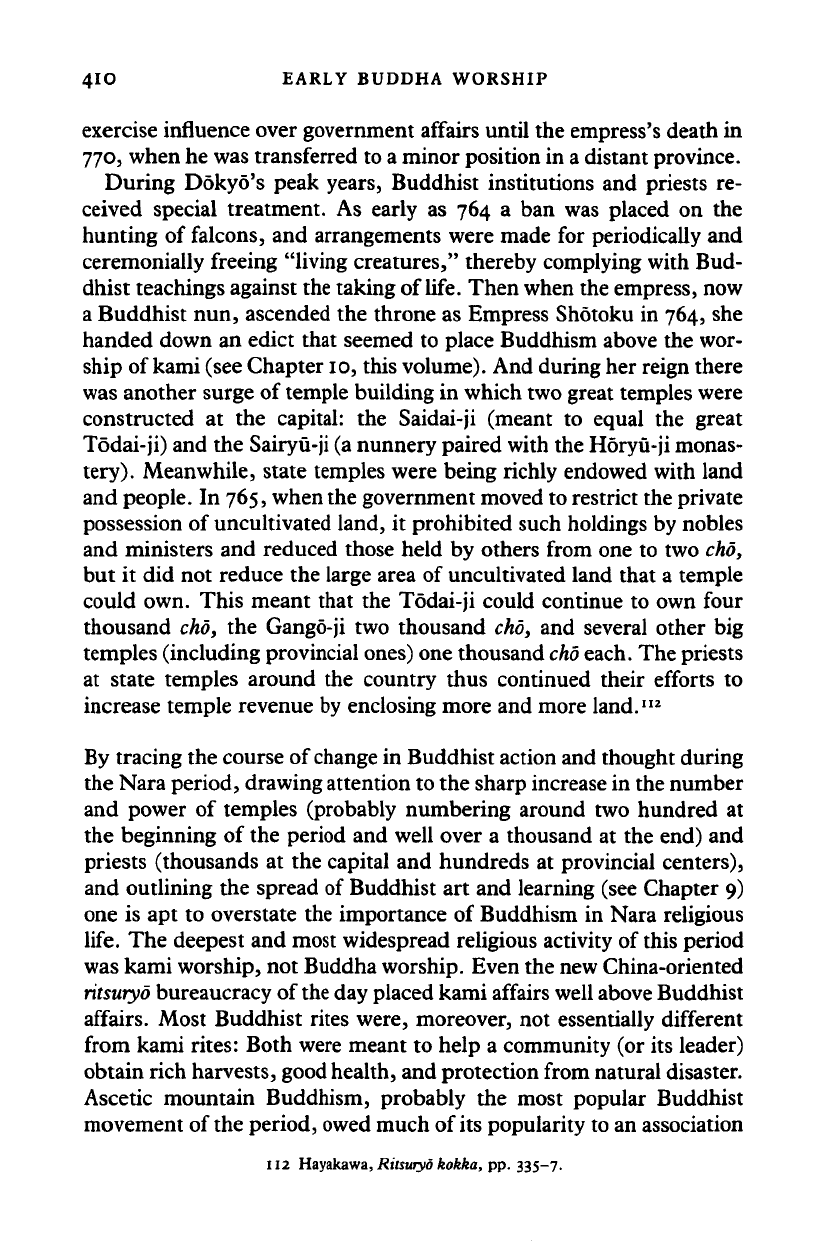
4IO EARLY BUDDHA WORSHIP
exercise influence over government affairs until the empress's death
in
770,
when he was transferred to a minor position in a distant province.
During Dokyo's peak years, Buddhist institutions
and
priests
re-
ceived special treatment.
As
early
as 764 a ban was
placed
on the
hunting
of
falcons,
and
arrangements were made
for
periodically and
ceremonially freeing "living creatures," thereby complying with Bud-
dhist teachings against the taking of
life.
Then when the empress, now
a Buddhist nun, ascended the throne as Empress Shotoku
in
764,
she
handed down
an
edict that seemed
to
place Buddhism above the wor-
ship of kami (see Chapter 10, this volume). And during her reign there
was another surge
of
temple building in which two great temples were
constructed
at the
capital:
the
Saidai-ji (meant
to
equal
the
great
Todai-ji) and the Sairyu-ji (a nunnery paired with the H6ryu-ji monas-
tery).
Meanwhile, state temples were being richly endowed with land
and people.
In
765,
when the government moved to restrict the private
possession
of
uncultivated land,
it
prohibited such holdings by nobles
and ministers
and
reduced those held
by
others from one
to
two cho,
but
it did not
reduce the large area
of
uncultivated land that
a
temple
could own. This meant that
the
Todai-ji could continue
to
own four
thousand cho,
the
Gango-ji
two
thousand cho,
and
several other
big
temples (including provincial ones) one thousand
cho
each. The priests
at state temples around
the
country thus continued their efforts
to
increase temple revenue by enclosing more and more land.
112
By tracing the course of change in Buddhist action and thought during
the Nara period, drawing attention to the sharp increase in the number
and power
of
temples (probably numbering around
two
hundred
at
the beginning
of
the period
and
well over
a
thousand
at the
end)
and
priests (thousands
at
the capital
and
hundreds
at
provincial centers),
and outlining
the
spread
of
Buddhist
art
and learning (see Chapter
9)
one
is apt to
overstate the importance
of
Buddhism
in
Nara religious
life.
The deepest and most widespread religious activity
of
this period
was kami worship, not Buddha worship. Even the new China-oriented
ritsuryo
bureaucracy of the day placed kami affairs well above Buddhist
affairs. Most Buddhist rites were, moreover,
not
essentially different
from kami rites: Both were meant
to
help
a
community (or its leader)
obtain rich harvests, good health, and protection from natural disaster.
Ascetic mountain Buddhism, probably
the
most popular Buddhist
movement of the period, owed much of its popularity to an association
112 Hayakawa,
Ritsutyo
kokka, pp. 335-7.
Cambridge Histories Online © Cambridge University Press, 2008
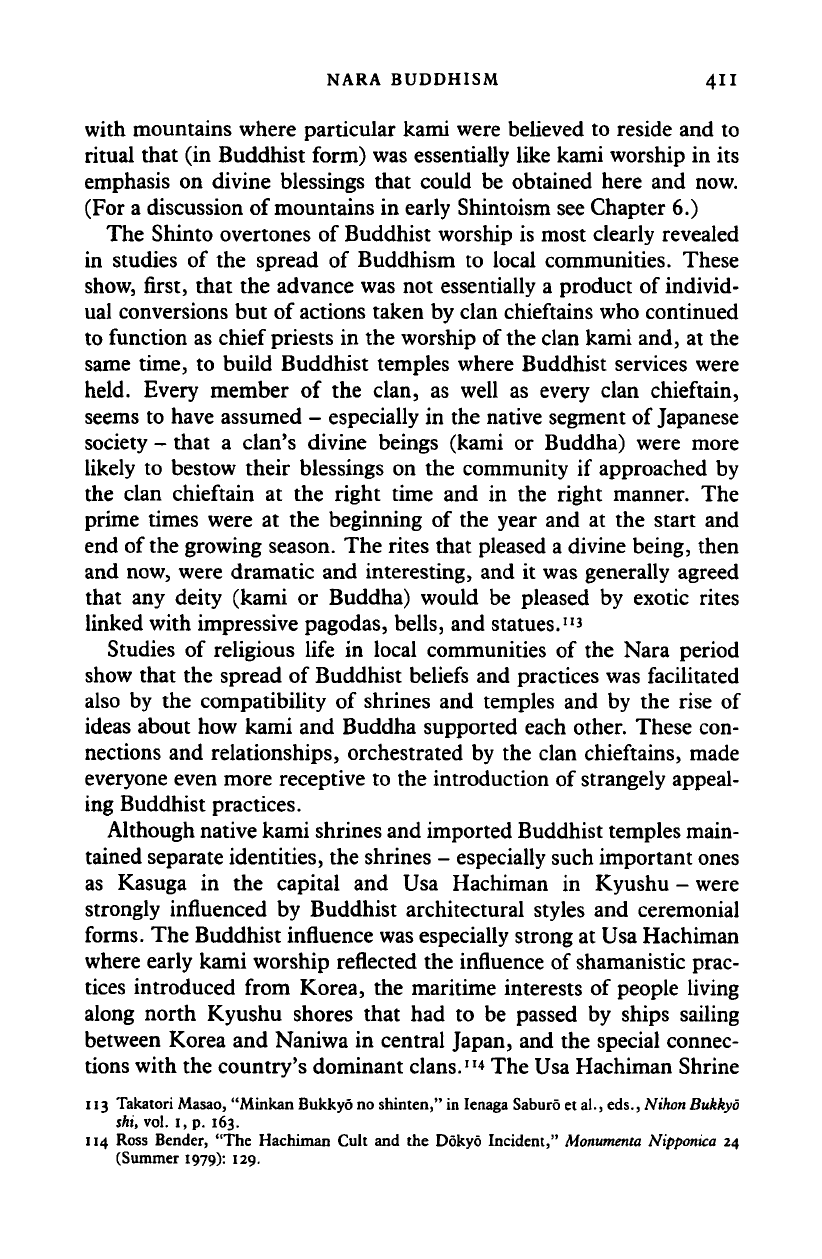
NARA BUDDHISM 411
with mountains where particular kami were believed to reside and to
ritual that (in Buddhist form) was essentially like kami worship in its
emphasis on divine blessings that could be obtained here and now.
(For a discussion of mountains in early Shintoism see Chapter 6.)
The Shinto overtones of Buddhist worship is most clearly revealed
in studies of the spread of Buddhism to local communities. These
show, first, that the advance was not essentially a product of individ-
ual conversions but of actions taken by clan chieftains who continued
to function as chief priests in the worship of the clan kami and, at the
same time, to build Buddhist temples where Buddhist services were
held. Every member of the clan, as well as every clan chieftain,
seems to have assumed - especially in the native segment of Japanese
society - that a clan's divine beings (kami or Buddha) were more
likely to bestow their blessings on the community if approached by
the clan chieftain at the right time and in the right manner. The
prime times were at the beginning of the year and at the start and
end of the growing season. The rites that pleased a divine being, then
and now, were dramatic and interesting, and it was generally agreed
that any deity (kami or Buddha) would be pleased by exotic rites
linked with impressive pagodas, bells, and statues."
3
Studies of religious life in local communities of the Nara period
show that the spread of Buddhist beliefs and practices was facilitated
also by the compatibility of shrines and temples and by the rise of
ideas about how kami and Buddha supported each other. These con-
nections and relationships, orchestrated by the clan chieftains, made
everyone even more receptive to the introduction of strangely appeal-
ing Buddhist practices.
Although native kami shrines and imported Buddhist temples main-
tained separate identities, the shrines - especially such important ones
as Kasuga in the capital and Usa Hachiman in Kyushu - were
strongly influenced by Buddhist architectural styles and ceremonial
forms.
The Buddhist influence was especially strong at Usa Hachiman
where early kami worship reflected the influence of shamanistic prac-
tices introduced from Korea, the maritime interests of people living
along north Kyushu shores that had to be passed by ships sailing
between Korea and Naniwa in central Japan, and the special connec-
tions with the country's dominant clans."
4
The Usa Hachiman Shrine
113 Takatori Masao, "Minkan Bukkyo no shinten," in Ienaga Saburo et al., eds., Nihon Bukkyo
shi, vol. 1, p. 163.
114 Ross Bender, "The Hachiman Cult and the Dokyo Incident," Monumenta Nipponica 24
(Summer 1979): 129.
Cambridge Histories Online © Cambridge University Press, 2008
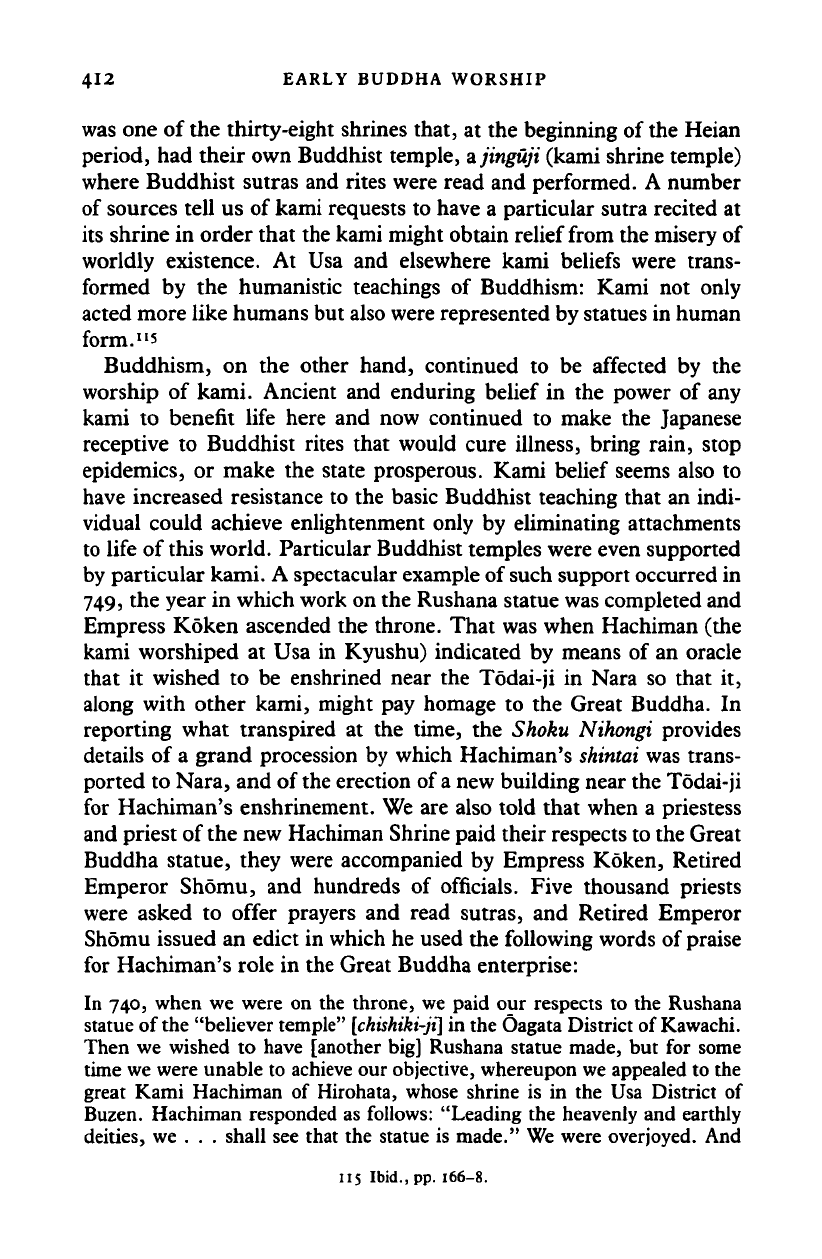
412 EARLY BUDDHA WORSHIP
was one of the thirty-eight shrines that, at the beginning of the Heian
period, had their own Buddhist temple, ajinguji (kami shrine temple)
where Buddhist sutras and rites were read and performed. A number
of sources tell us of kami requests to have a particular sutra recited at
its shrine in order that the kami might obtain relief from the misery of
worldly existence. At Usa and elsewhere kami beliefs were trans-
formed by the humanistic teachings of Buddhism: Kami not only
acted more like humans but also were represented by statues in human
form. "5
Buddhism, on the other hand, continued to be affected by the
worship of kami. Ancient and enduring belief in the power of any
kami to benefit life here and now continued to make the Japanese
receptive to Buddhist rites that would cure illness, bring rain, stop
epidemics, or make the state prosperous. Kami belief seems also to
have increased resistance to the basic Buddhist teaching that an indi-
vidual could achieve enlightenment only by eliminating attachments
to life of this world. Particular Buddhist temples were even supported
by particular kami. A spectacular example of such support occurred in
749,
the year in which work on the Rushana statue was completed and
Empress Koken ascended the throne. That was when Hachiman (the
kami worshiped at Usa in Kyushu) indicated by means of an oracle
that it wished to be enshrined near the T6dai-ji in Nara so that it,
along with other kami, might pay homage to the Great Buddha. In
reporting what transpired at the time, the Shoku Nihongi provides
details of a grand procession by which Hachiman's shintai was trans-
ported to Nara, and of the erection of a new building near the Tddai-ji
for Hachiman's enshrinement. We are also told that when a priestess
and priest of the new Hachiman Shrine paid their respects to the Great
Buddha statue, they were accompanied by Empress Koken, Retired
Emperor Shomu, and hundreds of officials. Five thousand priests
were asked to offer prayers and read sutras, and Retired Emperor
Shomu issued an edict in which he used the following words of praise
for Hachiman's role in the Great Buddha enterprise:
In 740, when we were on the throne, we paid our respects to the Rushana
statue of the "believer temple"
[chishiki-ji]
in the Oagata District of Kawachi.
Then we wished to have [another big] Rushana statue made, but for some
time we were unable to achieve our objective, whereupon we appealed to the
great Kami Hachiman of Hirohata, whose shrine is in the Usa District of
Buzen. Hachiman responded as follows: "Leading the heavenly and earthly
deities, we ... shall see that the statue is made." We were overjoyed. And
115 Ibid., pp. 166-8.
Cambridge Histories Online © Cambridge University Press, 2008
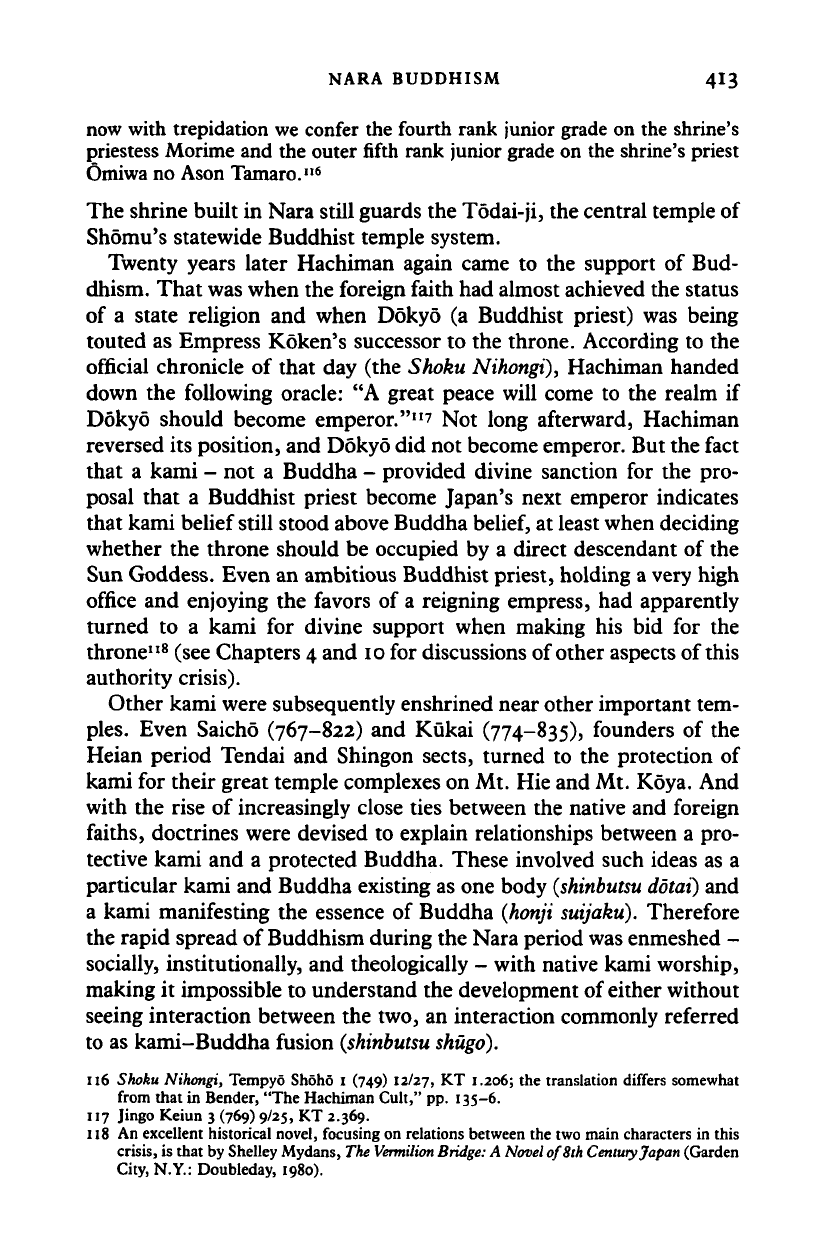
NARA BUDDHISM 413
now with trepidation we confer the fourth rank junior grade on the shrine's
priestess Morime and the outer fifth rank junior grade on the shrine's priest
Omiwa no Ason Tamaro."
5
The shrine built in Nara still guards the T6dai-ji, the central temple of
Shomu's statewide Buddhist temple system.
Twenty years later Hachiman again came to the support of Bud-
dhism. That was when the foreign faith had almost achieved the status
of a state religion and when Dokyo (a Buddhist priest) was being
touted as Empress Koken's successor to the throne. According to the
official chronicle of that day (the Shoku
Nihongi),
Hachiman handed
down the following oracle: "A great peace will come to the realm if
Dokyo should become emperor."
11
? Not long afterward, Hachiman
reversed its position, and Dokyo did not become emperor. But the fact
that a kami - not a Buddha - provided divine sanction for the pro-
posal that a Buddhist priest become Japan's next emperor indicates
that kami belief still stood above Buddha
belief,
at least when deciding
whether the throne should be occupied by a direct descendant of the
Sun Goddess. Even an ambitious Buddhist priest, holding a very high
office and enjoying the favors of a reigning empress, had apparently
turned to a kami for divine support when making his bid for the
throne
118
(see Chapters 4 and
10
for discussions of other aspects of this
authority crisis).
Other kami were subsequently enshrined near other important tem-
ples.
Even Saicho (767-822) and Kukai (774-835), founders of the
Heian period Tendai and Shingon sects, turned to the protection of
kami for their great temple complexes on Mt. Hie and Mt. Koya. And
with the rise of increasingly close ties between the native and foreign
faiths,
doctrines were devised to explain relationships between a pro-
tective kami and a protected Buddha. These involved such ideas as a
particular kami and Buddha existing as one body
(shinbutsu dotai)
and
a kami manifesting the essence of Buddha
(honji
suijaku).
Therefore
the rapid spread of Buddhism during the Nara period was enmeshed -
socially, institutionally, and theologically - with native kami worship,
making it impossible to understand the development of either without
seeing interaction between the two, an interaction commonly referred
to as kami-Buddha fusion
(shinbutsu
shugo).
116 Shoku Nihongi, Tempyo Shoho I (749) 12/27, KT 1.206; the translation differs somewhat
from that in Bender, "The Hachiman Cult," pp. 135-6.
117 Jingo Keiun 3 (769) 9/25, KT 2.369.
118 An excellent historical novel, focusing on relations between the two main characters in this
crisis,
is that by Shelley Mydans, The
Vermilion
Bridge:
A Novel of 8th Century Japan (Garden
City, N.Y.: Doubleday, 1980).
Cambridge Histories Online © Cambridge University Press, 2008
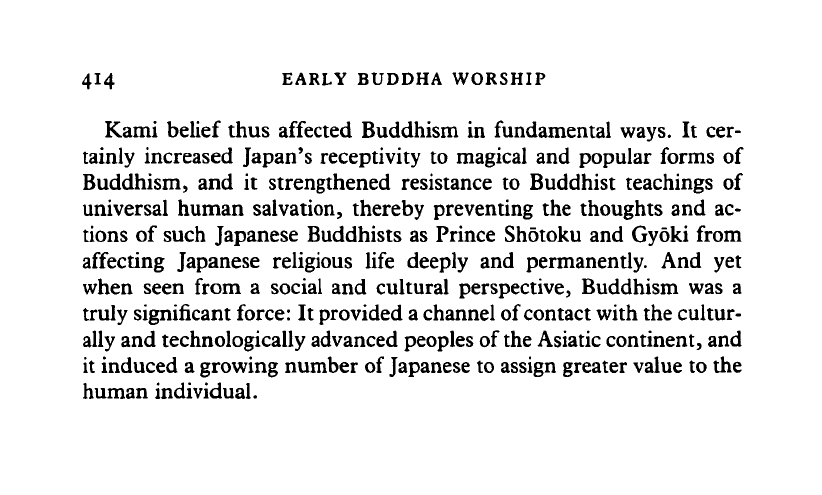
414 EARLY BUDDHA WORSHIP
Kami belief thus affected Buddhism in fundamental ways. It cer-
tainly increased Japan's receptivity to magical and popular forms of
Buddhism, and it strengthened resistance to Buddhist teachings of
universal human salvation, thereby preventing the thoughts and ac-
tions of such Japanese Buddhists as Prince Shotoku and Gyoki from
affecting Japanese religious life deeply and permanently. And yet
when seen from a social and cultural perspective, Buddhism was a
truly significant force: It provided a channel of contact with the cultur-
ally and technologically advanced peoples of
the
Asiatic continent, and
it induced a growing number of Japanese to assign greater value to the
human individual.
Cambridge Histories Online © Cambridge University Press, 2008
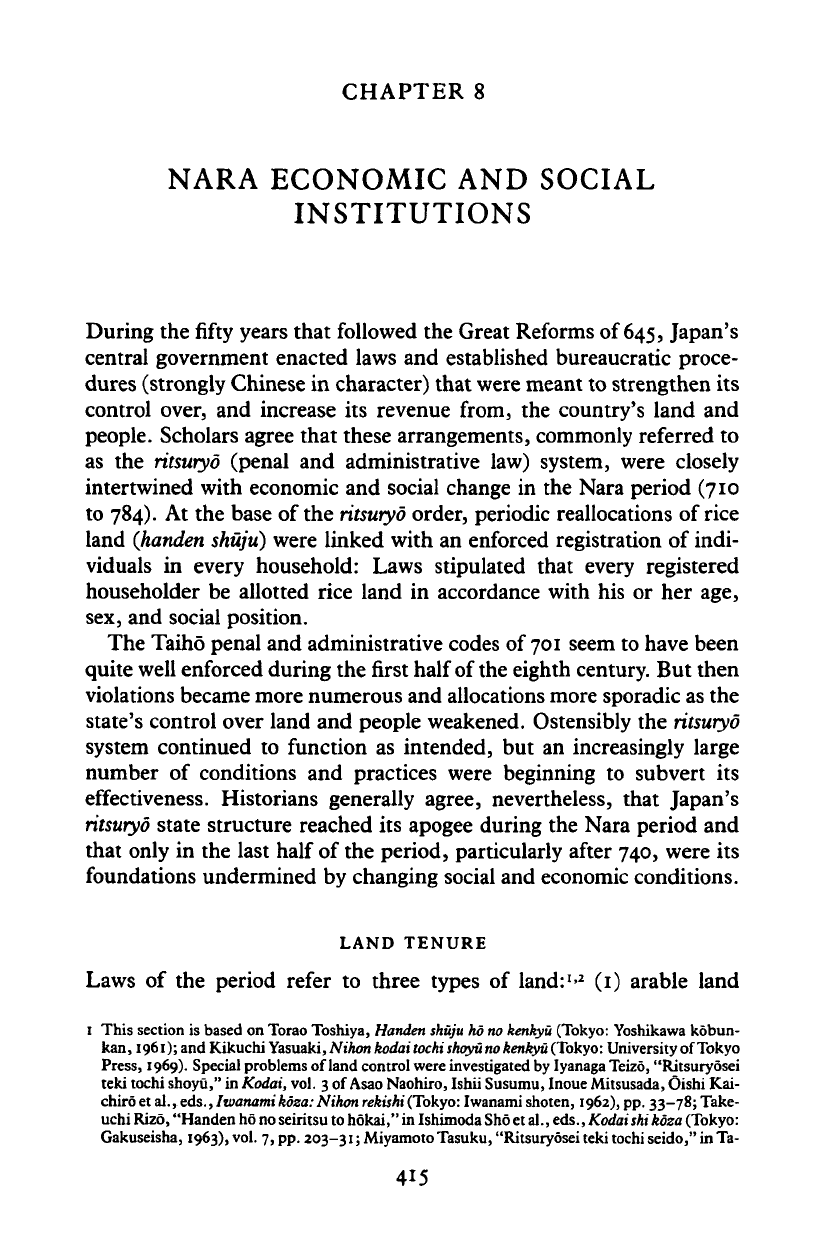
CHAPTER 8
NARA ECONOMIC AND SOCIAL
INSTITUTIONS
During the fifty years that followed the Great Reforms of
645,
Japan's
central government enacted laws and established bureaucratic proce-
dures (strongly Chinese in character) that were meant to strengthen its
control over, and increase its revenue from, the country's land and
people. Scholars agree that these arrangements, commonly referred to
as the ritsuryo (penal and administrative law) system, were closely
intertwined with economic and social change in the Nara period (710
to 784). At the base of the
ritsuryo
order, periodic reallocations of rice
land
(handen shuju)
were linked with an enforced registration of indi-
viduals in every household: Laws stipulated that every registered
householder be allotted rice land in accordance with his or her age,
sex, and social position.
The Taiho penal and administrative codes of
701
seem to have been
quite well enforced during the first half of
the
eighth century. But then
violations became more numerous and allocations more sporadic as the
state's control over land and people weakened. Ostensibly the ritsuryo
system continued to function as intended, but an increasingly large
number of conditions and practices were beginning to subvert its
effectiveness. Historians generally agree, nevertheless, that Japan's
ritsuryo state structure reached its apogee during the Nara period and
that only in the last half of the period, particularly after 740, were its
foundations undermined by changing social and economic conditions.
LAND TENURE
Laws of the period refer to three types of land:
1
-
2
(1) arable land
1 This section is based on Torao Toshiya, Handen
shuju
ho
no kenkyu
(Tokyo: Yoshikawa kobun-
kan,
1961);
and Kikuchi Yasuaki, Nihon kodai
tochi shoyu no kenkyu
(Tokyo:
University of Tokyo
Press,
1969). Special problems of
land
control were investigated by Iyanaga Teizo, "Ritsuryosei
teki tochi shoyu," in Kodai, vol. 3 of
Asao
Naohiro, Ishii Susumu, Inoue Mitsusada, Oishi Kai-
chiro etai.,eds.,Iwanamikoza: Nihon
rekishi
(Tokyo:
Iwanami shoten, 1962), pp. 33-78; Take-
uchi Rizo, "Handen ho no seiritsu to hokai," in Ishimoda Sho et al., eds., Kodai
shi
koza (Tokyo:
Gakuseisha, 1963), vol. 7, pp. 203-31; Miyamoto Tasuku, "Ritsuryosei teki tochi
seido,"
in Ta-
415
Cambridge Histories Online © Cambridge University Press, 2008
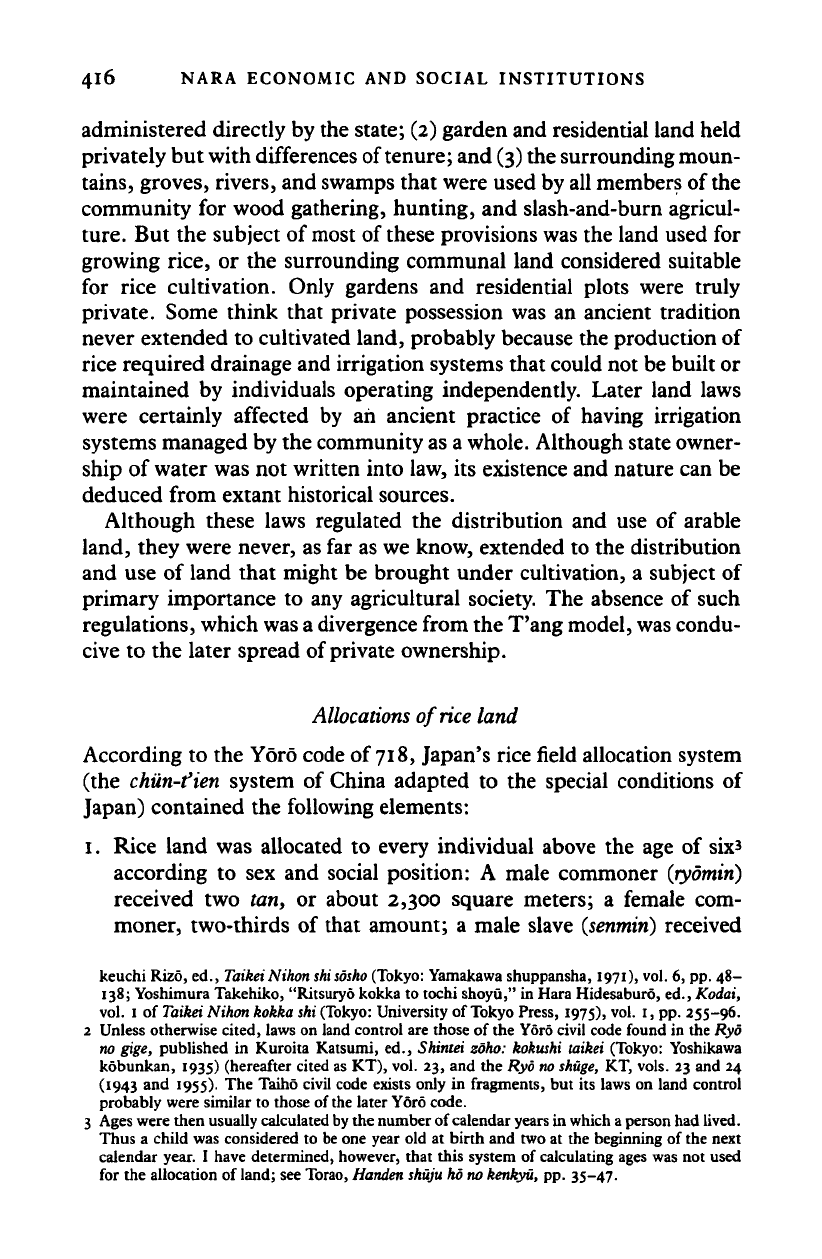
416 NARA ECONOMIC AND SOCIAL INSTITUTIONS
administered directly by the state; (2) garden and residential land held
privately but with differences of tenure; and
(3)
the surrounding moun-
tains,
groves, rivers, and swamps that were used by all members of the
community for wood gathering, hunting, and slash-and-burn agricul-
ture.
But the subject of most of these provisions was the land used for
growing rice, or the surrounding communal land considered suitable
for rice cultivation. Only gardens and residential plots were truly
private. Some think that private possession was an ancient tradition
never extended to cultivated land, probably because the production of
rice required drainage and irrigation systems that could not be built or
maintained by individuals operating independently. Later land laws
were certainly affected by ah ancient practice of having irrigation
systems managed by the community as
a
whole. Although state owner-
ship of water was not written into law, its existence and nature can be
deduced from extant historical sources.
Although these laws regulated the distribution and use of arable
land, they were never, as far as we know, extended to the distribution
and use of land that might be brought under cultivation, a subject of
primary importance to any agricultural society. The absence of such
regulations, which was a divergence from the T'ang model, was condu-
cive to the later spread of private ownership.
Allocations of rice land
According to the Yoro code of
718,
Japan's rice field allocation system
(the chun-fien system of China adapted to the special conditions of
Japan) contained the following elements:
1.
Rice land was allocated to every individual above the age of six*
according to sex and social position: A male commoner
(rydmiri)
received two tan, or about 2,300 square meters; a female com-
moner, two-thirds of that amount; a male slave
(senmin)
received
keuchi Rizo, ed.,
TaikeiNihon shisosho
(Tokyo:
Yamakawa shuppansha, 1971), vol. 6, pp. 48-
138;
Yoshimura Takehiko, "Ritsuryo kokka to tochi shoyu," in Hara Hidesaburd, ed., Kodai,
vol.
1
of
Taikei Nihon kokka shi
(Tokyo:
University of Tokyo Press, 1975), vol. 1, pp. 255-96.
2 Unless otherwise cited, laws on land control are those of the Yoro civil code found in the Ryo
no
gige,
published in Kuroita Katsumi, ed., Shintei
zoho:
kokushi taikei
(Tokyo: Yoshikawa
kobunkan, 1935) (hereafter cited as KT), vol. 23, and the Ryo
no
shuge,
KT, vols. 23 and 24
(1943 and 1955). The Taiho civil code exists only in fragments, but its laws on land control
probably were similar to those of
the
later Yoro code.
3
Ages
were then usually calculated
by
the number of calendar years in which
a
person had lived.
Thus a child was considered to be one year old at birth and two at the beginning of the next
calendar year. I have determined, however, that this system of calculating ages was not used
for the allocation of land; see Torao,
Handen shuju ho no
kenkyu,
pp. 35-47.
Cambridge Histories Online © Cambridge University Press, 2008
